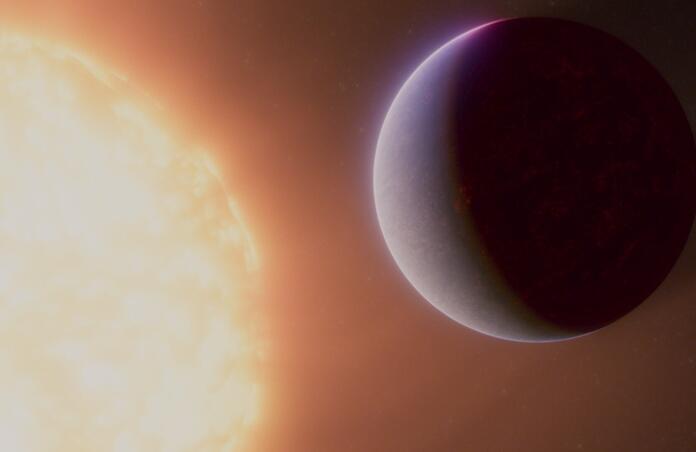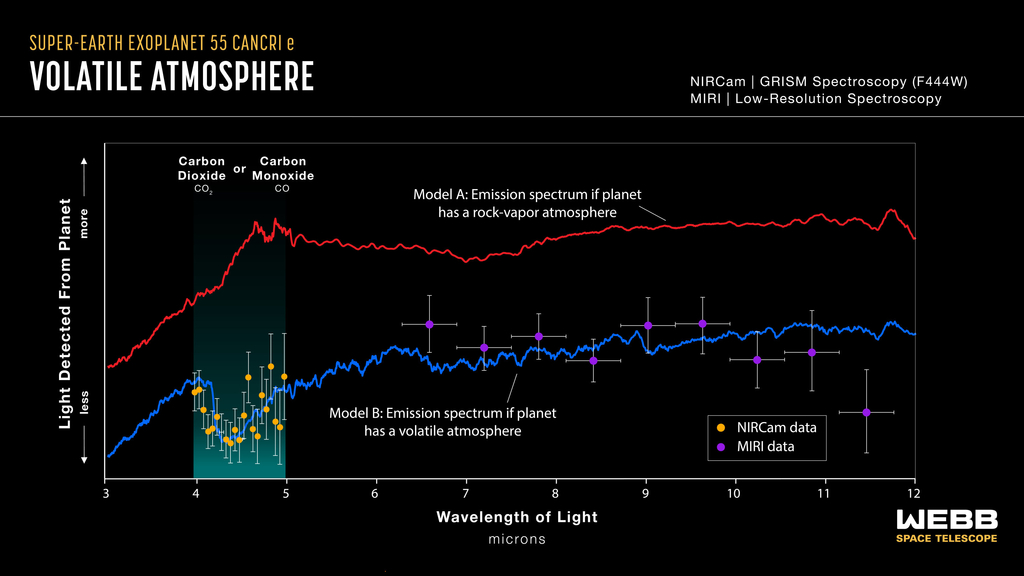Best evidence yet of a rocky exoplanet atmosphere

A team of international researchers have possibly detected an atmosphere around the rocky exoplanet 55 Cancri e, publishing the best evidence yet for a rocky planet atmosphere outside the solar system in the journal Nature.
55 Cancri e is one of the five known exoplanets orbiting a solar-like star in the constellation Cancer, located 41 light years away. The planet is larger than Earth but smaller than Neptune, making it a super-earth, its composition similar to the rocky solar system planets. Since its discovery by transit in 2011, there has been an ongoing question regarding whether or not the planet possesses an atmosphere. Previous studies using data from NASA’s Spitzer Space Telescope have suggested the existence of a substantial atmosphere, rich in volatiles such as oxygen, nitrogen and carbon dioxide. However, the picture of a bare planet blanketed in a thin layer of vaporised rock also can’t be ruled out.
"55 Cancri e is one of the most enigmatic exoplanets. Despite enormous amounts of observing time obtained with a dozen of ground and space facilities in the past decade, its very nature has remained elusive, until today, when parts of the puzzle could finally be put together thanks to the James Webb Space Telescope (JWST)" explained Brice-Olivier Demory, Center for Space and Habitability of the University of Bern and co-author of the study.
Demory was invited to work on the research program by Renyu Hu from NASA’s Jet Propulsion Laboratory (JPL), who led the team. Demory’s interest in 55 Cancri e has spanned his entire career. "As a Postdoc at MIT I led the discovery of the first transit of 55 Cancri e, and in 2016 my team published the first map of a rocky exoplanet, which was 55 Cancri e." The results from 2016 pointed towards the presence of an atmosphere around the planet.
Concerning the most recent study, Demory carried out an independent analysis of the JWST data. "In the past two years, the space telescope CHEOPS which has been developed and built at the University of Bern, has been key in solving several questions that astrophysicists had about 55 Cancri e. JWST complemented this picture at infrared wavelengths in showing that the super-Earth 55 Cancri e might be surrounded by an atmosphere with a composition consistent with carbon monoxide or carbon dioxide" he stated.
Although 55 Cancri e is described as a rocky exoplanet, this may be slightly misleading. The planet has an extremely close in orbit, making one full rotation around its star in just 18 hours causing its surface to be molten. Additionally, the close distance means the planet is tidally locked. The same hemisphere is always facing the star – the dayside – whilst the other is in eternal darkness.
A direct image of the system cannot be taken by JWST, however, the changes in light as the planet orbits can be observed. The team used NIRCam and MIRI to track the infrared light emitted from the planet between 4 and 12 microns. The amount of infrared light coming only from the dayside of the planet was calculated by subtracting the brightness when the planet is behind the star (secondary eclipse) from the brightness when the planet is next to the star. This was calculated at multiple wavelengths, forming an emission spectrum.
The first indicator of an atmosphere was from temperature measurements based on the thermal emission. If the planet was covered in dark molten rock with a thin cover of vaporised rock or no atmosphere at all, the dayside should reach a sweltering 2200 degrees Celsius. However, MIRI data revealed a much cooler temperature of 1500 degrees Celcius. This is a very strong indication that energy is being distributed from the dayside to the nightside, most likely by a volatile-rich atmosphere."
Currents of lava are capable of carrying some heat to the nightside, however, it cannot be moved efficiently enough by this process to explain the cooling effect observed. The dayside is several hundred degrees cooler than expected, even if the heat was evenly spread around the planet. This would be explained if some of the infrared light emitted by the planet is being absorbed by an atmosphere, therefore never reaching the telescope.

When the team looked at the NIRCam data, features in the spectrum consistent with a volatile rich atmosphere were also seen. A dip in the spectrum between 4 and 5 microns suggests the presence of carbon monoxide or carbon dioxide, since both absorb at these wavelengths.
It is thought that the gases covering 55 Cancri e come from its interior. There would be no primary atmosphere due to the high temperatures and intense stellar radiation. Therefore, the present atmosphere is a secondary atmosphere that is constantly replenished by a magma ocean.
Although 55 Cancri e is clearly not habitable, studying this magma world would provide a unique opportunity to understand the interactions between atmospheres, surfaces and interiors of rocky planets, providing insight into the early Earth, Venus and Mars which were once covered in magma oceans.
"Ultimately, we want to understand what conditions make it possible for a rocky planet to sustain a gas-rich atmosphere: the key ingredient for a habitable planet," said Hu.
--
Cover image: University of Bern, Switzerland
Journal source: Renyu Hu et al, A secondary atmosphere on the rocky Exoplanet 55 Cancri e, Nature (2024). DOI: 10.1038/s41586-024-07432-x
